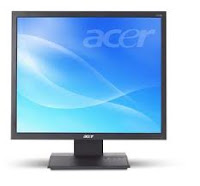Output devices
Out put devices are used to display results of processing to the user. They perform the following functions:
Examples include: Monitor, printer, plotter, speaker, and multimedia projector.
1. Monitor
Monitor is the most commonly used output device used to display results of processing. It has a TV like shape. Pictures on monitor are formed with picture elements called PIXEL. Monitors may be Monochrome that will display results in Black & White. Color Monitors are also available. They display results in multi colors. Monitor produces soft copy output.
2. Printers
Printers are used to produce hard copy out put. They print processing results on paper. Printers are divided into two main categories:
· Impact Printers
· Non Impact printers
Impact Printers.
These printers print with striking of hammers or pins on ribbon. For example Dot Matrix printer and daisy wheel printers are impact printers.
Non-Impact Printers.
These printers do not use striking mechanism for printing. They use electrostatic and laser technology. Quality and speed of these printers is better than Impact printers. For example Laser printer and Inkjet printers are non-impact printers.
3. Speaker and Headsets
Speakers and head sets produce sound output. We can listen recorded voices, sounds or music with the help of speaker or headset. Speaker produces sound output with the help of sound card.
4. Plotter
A plotter is an output device used to produce image-quality graphics in a variety of colors. Plotters are used to print large maps, architectural drawings, graphs and charts. Plotters are used to draw different designs of buildings or internal structure of machines. Plotters offer the fastest way to efficiently produce very large drawings or color high-resolution graphics. Engineers and Architects use plotters.
5. Multimedia Projector.
Multimedia projector is used to produce computer output on a big screen. These are used in meeting rooms or in classrooms of educational institutes. Since the output produced by multimedia projector is displayed on a large screen, it can be viewed by a large number of people in a hall, meeting / conference room or a class room. Mostly teachers use data projectors in class rooms for delivering lectures ( a use of audio visual aids technology)
2.2 What are Different Types of Input Devices
2.3 Explain Different Types Of Output Devices
2.4 Explain Parts of CPU and its Working
2.5 What are Dual Devices or Both Input/ Output Devices
2.6 What is RAM, Explain Different Types of RAM
2.7 What is ROM Explain Different Types of ROM
2.8 Discuss Differences Between RAM and ROM
2.9 Explain different types of storage devices
2.10 What are Pointing Input Devices
2.11 Different Types of Mouse Input Device
2.12 Types Of Scanners Input Device
Out put devices are used to display results of processing to the user. They perform the following functions:
- Receive results from memory
- Convert data into human readable form
- Display results to the user
Different Types of Output Devices
1. Monitor
 |
| LCD Monitor |
 |
| CTR Monitor |
Monitor is the most commonly used output device used to display results of processing. It has a TV like shape. Pictures on monitor are formed with picture elements called PIXEL. Monitors may be Monochrome that will display results in Black & White. Color Monitors are also available. They display results in multi colors. Monitor produces soft copy output.
2. Printers
Printers are used to produce hard copy out put. They print processing results on paper. Printers are divided into two main categories:
· Impact Printers
· Non Impact printers
Impact Printers.
These printers print with striking of hammers or pins on ribbon. For example Dot Matrix printer and daisy wheel printers are impact printers.
Non-Impact Printers.
These printers do not use striking mechanism for printing. They use electrostatic and laser technology. Quality and speed of these printers is better than Impact printers. For example Laser printer and Inkjet printers are non-impact printers.
 |
| Speakers for Desktop computer |
Speakers and head sets produce sound output. We can listen recorded voices, sounds or music with the help of speaker or headset. Speaker produces sound output with the help of sound card.
 |
| Headsets - used to produce audio output |
4. Plotter
A plotter is an output device used to produce image-quality graphics in a variety of colors. Plotters are used to print large maps, architectural drawings, graphs and charts. Plotters are used to draw different designs of buildings or internal structure of machines. Plotters offer the fastest way to efficiently produce very large drawings or color high-resolution graphics. Engineers and Architects use plotters.
5. Multimedia Projector.
 |
| Multimedia Projector |
Computer Hardware
Concepts
2.1 What
are Different Types of Hardware2.2 What are Different Types of Input Devices
2.3 Explain Different Types Of Output Devices
2.4 Explain Parts of CPU and its Working
2.5 What are Dual Devices or Both Input/ Output Devices
2.6 What is RAM, Explain Different Types of RAM
2.7 What is ROM Explain Different Types of ROM
2.8 Discuss Differences Between RAM and ROM
2.9 Explain different types of storage devices
2.10 What are Pointing Input Devices
2.11 Different Types of Mouse Input Device
2.12 Types Of Scanners Input Device



Comments